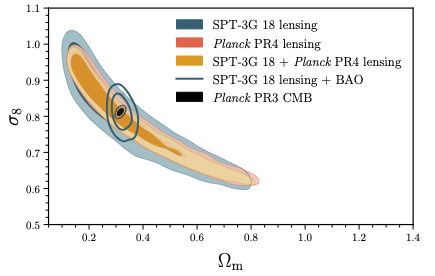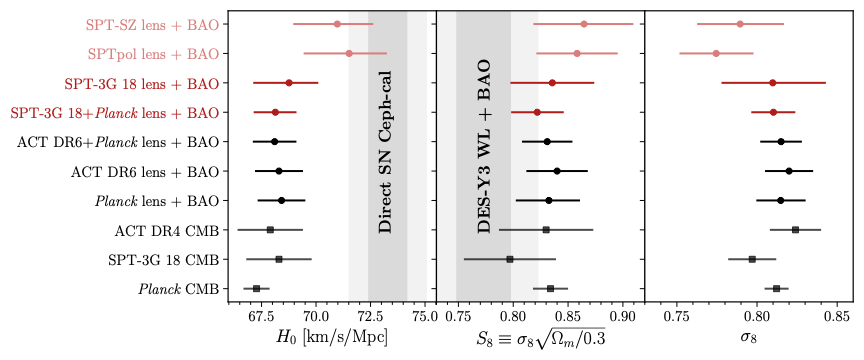|
Project Supported by
|
NSF, National Science Foundation
KICP, Kavli Institute for Cosmological Physics
USAP, United States Antarctic Program
Antarctic Support Contract
|
|
|
Related Websites
|
CBI, Cosmic Background Imager
DASI, Degree Angular Scale Interferometer
WMAP, Wilkinson Microwave Anisotropy Probe
|
|
|
|
 | Overview |
|
 |
|
| |
This page provides data products associated with the cosmological parameters analysis of the SPT-3G 2018 CMB lensing power spectra over 1500 square degrees described in arXiv:2308.11608, Pan et al., (2023).
The lensing band powers are presented over the multipole range 50 <= L <= 2000 and can be used to constrain cosmological models using the Cobaya likelihood package provided below.
If you have any questions regarding this data set or its use, please contact Federico Bianchini (fbianc_at_stanford_dot_edu) or Zhaodi Pan (panz_at_anl_dot_gov).
|
| |
 | Figures |
|
 |
|
| |
Individual figures are available in PDF format here or bundled in a tarball here. We highlight some figures below.
|  Lensing power spectrum measurements from this work, SPT-SZ, SPTpol, POLARBEAR, BICEP/Keck, Planck, and ACT. We also plot the lensing spectrum from the best-fit LCDDM model to the 2018 Planck TTTEEE+lowE+lensing dataset (solid gray line) . (Figure 5 in Pan et al., 2023)
Lensing power spectrum measurements from this work, SPT-SZ, SPTpol, POLARBEAR, BICEP/Keck, Planck, and ACT. We also plot the lensing spectrum from the best-fit LCDDM model to the 2018 Planck TTTEEE+lowE+lensing dataset (solid gray line) . (Figure 5 in Pan et al., 2023)
|
 Constraints in the Omega_m-sigma8 plane from our SPT-3G CMB lensing measurements (filled blue contours).
For comparison, we also include results from Planck PR4 lensing (red contours) as well as its combination with SPT-3G lensing data (yellow contours).
The empty blue contours show the constraints combining our SPT-3G lensing likelihood with BAO data.
The black filled contours representing the independent constraints derived from the Planck primary CMB power spectra are also found to be consistent with the CMB lensing measurements at lower redshifts. (Figure 8 in Pan et al., 2023)
Constraints in the Omega_m-sigma8 plane from our SPT-3G CMB lensing measurements (filled blue contours).
For comparison, we also include results from Planck PR4 lensing (red contours) as well as its combination with SPT-3G lensing data (yellow contours).
The empty blue contours show the constraints combining our SPT-3G lensing likelihood with BAO data.
The black filled contours representing the independent constraints derived from the Planck primary CMB power spectra are also found to be consistent with the CMB lensing measurements at lower redshifts. (Figure 8 in Pan et al., 2023)
|
 A comparison of the marginalized constraints on the Hubble constant H0, S8, and sigma8 (left to right) across different cosmological probes and surveys. The direct H0 measurement is taken from Murakami et al., while the LSS-based constraint on S8 is taken from the reanalysis of the DES-Y3 (+ BAO) data presented in Madhavacheril et al. (Figure 10 in Pan et al., 2023)
A comparison of the marginalized constraints on the Hubble constant H0, S8, and sigma8 (left to right) across different cosmological probes and surveys. The direct H0 measurement is taken from Murakami et al., while the LSS-based constraint on S8 is taken from the reanalysis of the DES-Y3 (+ BAO) data presented in Madhavacheril et al. (Figure 10 in Pan et al., 2023)
|
| |
 | Bandpowers |
|
 |
|
| |
Bandcenters, bandpowers, and bandpower errors for plotting are provided in a text file
here.
Bandpowers and uncertainties are given in [L_b(L_b + 1)]^2 /2/pi
units. Each row is one ell-bin. The columns are (1) bin number, (2)
L_min, (3) L_max, (4) center of bin, (5) estimated clpp bandpower, (6)
sigma on the estimated clpp bandpower, (7) lensing amplitude compared
to the 2018 Planck TTTEEE+lowE+lensing cosmology.
Note that these bandpowers are not foreground subtracted.
The foreground contamination template is provided in the Cobaya likelihood dataset below.
|
| |
 | Likelihood Code |
|
 |
|
| |
We provide files in a zipped file here the SPT-3G 2018 1500d CMB lensing likelihood.
The Cobaya likelihood contains the lensing bandpowers, the corresponding lensing bandpowers covariance matrix, the lensing linear corrections, and the foreground-bias template that can be marginalized over.
The appropriate dataset files for running CMB lensing-only and CMB lensing + external data are provided as well.
A simple README file provides details on how to install and run the Cobaya likelihood.
If you have any questions regarding the use of this likelihood, please contact Federico Bianchini (fbianc_at_stanford_dot_edu).
v1.0: Jan 21, 2024 - Initial version released with published PRD paper.
|
| |
|
|